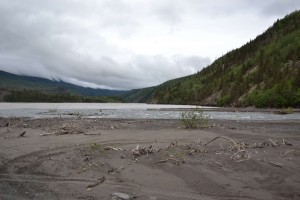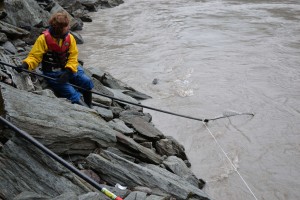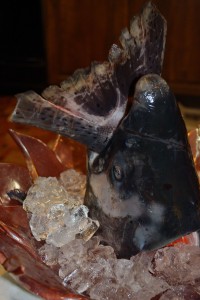Very shortly after I returned from fieldwork in Russia this year, Rose and I packed up and headed for Chitina to catch enough salmon for another year of tasty fish. Copper River red salmon, recognized as prize gastronomic fare, is available to Alaska residents through a “personal use fishery” on the Copper River while the salmon are running. A household of two or more can catch 30 red salmon or 29 reds and a king. The latter combination is about as good as fish eating gets, raw or cooked.
As we drove the six or seven hours to get to the Copper River at Chitina, we realized that this was our tenth year of dip netting. Some years have been more successful than others, but we have it down fairly well now and have gotten our limit for three years running. There was a little uncertainty in that this year, though. You have to go early if you’re going to get a king salmon, and going early poses a risk of not catching your limit. So we went a little early—actually, the only time when both of us could really get away. But it was slow. Mark Hem, one of the charter boat operators, told us it was slow, and he was right. It reminded me of the year that Sam McAllister and his brother Roger said that “Fishing is shitty.” Truth in advertising brings your customers back. We’ve been happy customers for a decade, whether we’ve gotten our limit or not.
We’ve always gone with a charter, because we haven’t had a vehicle that could get us to where we could scale the bluff or cliff ourselves. Dip netting in the Copper River occurs where the river is forced through a canyon, so the banks are very steep and rocky, and the river itself is a roiling madhouse of angry water. Now that the road is mostly impassable, few people can go beyond O’Brien Creek without a charter, at least into the canyon, where the water and the fish become most concentrated. The raging current encountering the rough, rocky banks often causes back-currents. It is here where the fish, migrating upstream to their spawning grounds, find easier passage, and dip netters can have their nets spread in an upstream direction to hopefully catch the tasty creatures. The water, coming right off of the Wrangell-St. Elias glaciers, is very cold and very turbid with suspended particles. You can’t see a quarter of an inch into it. So as a netter you just stand there with your net in the water and wait until a fish bumps it. Or just wait, and wait, and wait.
The river is a rough and unforgiving body of water here, so you are best off wearing a life jacket and tying yourself off to something solid onshore. It’s not a good place for a family outing. There’s nothing to stop you from a long float downriver if you are unfortunate enough to fall in without being tied off. And in that cold, roiling water survival is very uncertain. We always bring enough rope to tie off. Once I get the feel of a site and get comfortable with it, I often just have the net tied off (high on the closed handle) and make my brain realize that if I fall in to hang the hell on. But I think that a very large king salmon at the wrong moment could inadvertently change all that in a heartbeat. Nobody plans to fall in, but people have died dip netting. We’re pretty careful.
This year we left Fairbanks rather late in the afternoon after stocking up on ice and snacks at the grocery store. We camped near Chitina and got up before 5:00 a.m. to drive the last few miles and get in line for a charter boat. We set out on a gorgeous morning—blue skies and clear. It hasn’t always been this way. We prepare for rain, wind, and cool weather and are ready to strip down and put on sun screen if we get lucky. And this year we did just that. We were catching fish by 8:00 a.m. on our own little rock beside the raging river, and we pulled in enough by the 10:00 a.m. lull (which we’ve come to expect) that we were excited. But the lull was long and deep, so by 12:00 we were wondering whether we would get a king OR our limit.
We’d had relatively few bumps that we hadn’t picked up, but the sunny day had the water rising and the currents subtly changing, so where the fish were and how they were moving was changing. You have to keep on sampling different ways to fish when things slow down—deeper, on the up-side of whirlpools, sweeping pools, etc. It’s very hard work. Just holding your net steady in the turbulent water can be an arduous job. But we kept at it, and number 17 was a beautiful king. When it hit my net I knew exactly what it was. There’s an amazing amount of strength in a big fish, and having a king hit your net feels a lot like it probably would if you closed your eyes and stuck a net out in front of city traffic. I immediately began pulling in the net, but partway in both the king and I stopped fighting because it wasn’t entirely clear what to do next to win. With the king (a yard long or more) halfway in and out of my net, I had to determine how to manipulate it to get him more in than out. As we mutually assessed the situation, I let my subconscious take over. My hands knew which side was the front of the net, so I swept him in and hauled the bucking bronco into the air. Wow! Human muscles and adrenaline won the day, and after I beat it senseless and Rose took a couple of pictures I broke out a new stringer and put it in the water to keep it cool.
We’ve learned a bit about clubbing and clipping fish. The rule is no mercy. Club them senseless before removing them from the net, clip the tail corners as the law requires, clip a gill arch or two to bleed them, then put them into the cold river on a stringer to keep them cool. Fewer cut fingers (from their teeth), no lost fish, and less tangled stringers are the result. I don’t feel the need to wear gloves anymore, unless it’s cold.
The next fish I encountered was a king, too, but this one got away with only a short wrestling match that showed me a tail of about the same size as the one we already had. You can only get one, so I was happy to not have to fight another.
Having your butt cheeks clenching a rock for eight hours can be tiring, and it was nearly eight hours of hard labor this year before we reached our limit. Rose pulled in number 30, and we were happy to have it as the charter passed and we signaled for a pickup. We packed up and had a snack before zooming back upriver to O’Brien Creek.
At O’Brien Creek we did a rough cleaning before putting the fish onto ice, then we headed for home, tired but with coolers full. We stopped in Chitina for more ice and some ice cream, then pushed on for home. We camped for the night at one of our favorite spots—a gravel pit where Gray-cheeked Thrushes (Catharus minimus) can be counted on to sing late into the long crepuscular period of night. This completed for us the trifecta of greater North American Catharus thrushes: Swainson’ Thrushes (C. ustulatus) had sung us to sleep the night before; Hermit Thrushes (C. guttatus) had sprinkled the cliffside dawn and morning with their delightfully haunting songs; and now, at high elevation near Summit Lake, the most ethereal singer of the genus cast its rapid, somewhat buzzy, flutelike songs to the midnight sun. For such unprepossessing birds they are among the world’s most beautiful songsters. It perks up the soul to be a part of their world, however fleetingly.
Next morning we completed our return to Fairbanks, attended briefly to business at school, then rolled up our sleeves and began processing fish. Putting those tasty, bagged filets into the freezer is one of those pleasures you relish because you know how much enjoyment they’re going to bring all winter long. And grilling a whole, fresh fish over wood chips for dinner is about as good as it gets.
Industrial fish cleaning and slime control
We’re picky about our fish. They are bled as they are put on the stringer and kept cool in the river until we return to O’Brien Creek (unless they are hitting so fast that the pile doesn’t have time to warm up). Because the Copper River is so silty and the fish have had their natural silt control (and life) stripped from them, they can look pretty ugly from silt accumulation. At O’Brien Creek all is put right, at least as far as food is concerned. There, we do not filet them. Instead, all we do is gut them, rinse them well in the creek, then pack them in ice for the trip home—heads on and all. Part of this is just to keep the skin and any slime from ever touching the meat. Another part is just that we can clean and pack fish a lot better in our kitchen than on a gravel bar in blowing wind and/or hot sun at the end of a long and tiring day. Derek Sikes invented the phrase “industrial fish cleaning,” and for 30 salmon it fits very well.
Out on the Copper River here’s what we use:
– Life jackets.
– Hat and rain gear.
– Rope to tie off you and/or your net.
– A small plastic box to carry our junk and lunch.
– Long-handled nets. The handles are 12 feet long, and the nets themselves are 32 inches across. After ten years, it looks like we need to replace the nets. We keep a roll of braided nylon in our box to make repairs on the fly—increasingly necessary. This year we had a couple of aggravating escapes.
– A club to stun the fish.
– Heavy duty metal shears (aviation shears) to cut tail corners and gill arches (clipping the corners of the tail is required by state regulation).
– Heavy duty stringers. Most people just use rope, but we’ve seen fish lost several times and so have adopted a belt-and-suspenders method instead. Five or six fish to a stringer is as much weight as you want to put on there, but still the bottom-most, tie-off fish can break off and allow the others to slip off as well (we watched one guy lose at least six fish this way!). We’ve gone to heavy-duty, metal chain-and-clip stringers AND a light rope through the opposite gill to assure that every fish comes home with us. A king gets its own stringer.
– Sunglasses and sun screen (ever hopeful!)
– Heavy duty pocket knife. For gutting; more on that above.
– Large marine coolers (ca. 120 quart, two)
– Ice. We usually leave Fairbanks with 12 bags of cheap ice and replenish in Chitina or Delta Junction (ice is more expensive in both) if we need to.
Back home we use:
– A vacuum sealer with 8″ wide bags from the roll they sell for it. This year our first sealer died (it had handled many hundreds of pounds of fish and game), but we had a new one in a short time from Fred Meyer’s.
– A large freezer.
– A king salmon head soup recipe.
– Soy sauce and wasabi for sashimi.
– Wood chips for smoke-grilling.
On sashimi, we (and by that I mean I) learned the hard way that you need to freeze your fish first to kill parasite eggs. But sashimi delicately shaved from fresh-frozen salmon is exquisitely delicious with some wasabi diluted in soy sauce. We usually eat nothing but this for two or three evenings after bringing home a load of fish.
And from our very first king salmon and the story therefrom, a recipe that we have not surpassed:
King salmon bouillabaisse with wild rice and roasted garlic, over baby asparagus with scallions and parmesan cheese.
Simmer 1 king salmon head and skeleton in water with some thyme, bay leaf, salt, and pepper. Cool, pick meat, discard bones and skin. Simmer stock for several hours to concentrate, then add wild rice and barley. After half an hour more of simmering, add carrots, celery, onions, garlic, fish sauce, white wine, V8, and salt and pepper to taste. In the last ten minutes, add fish meat back and (separately) cook asparagus and place in bowl. Pour soup over asparagus and sprinkle on chopped scallions and freshly grated parmesan cheese.




